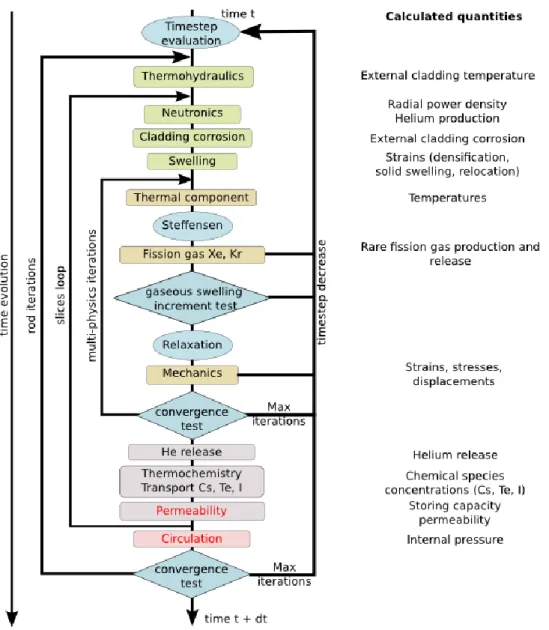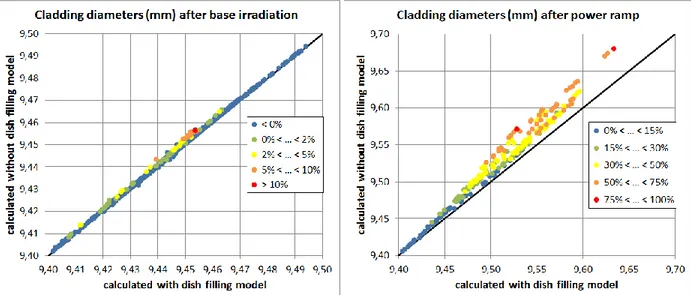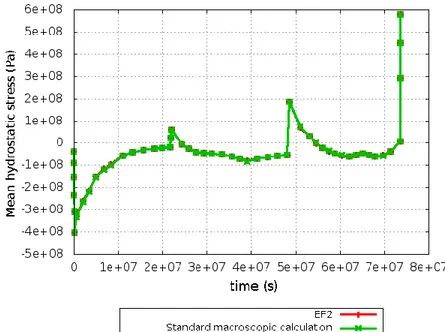HAL Id: cea-02439467
https://hal-cea.archives-ouvertes.fr/cea-02439467
Submitted on 26 Feb 2020
HAL is a multi-disciplinary open access
archive for the deposit and dissemination of
sci-entific research documents, whether they are
pub-lished or not. The documents may come from
teaching and research institutions in France or
abroad, or from public or private research centers.
L’archive ouverte pluridisciplinaire HAL, est
destinée au dépôt et à la diffusion de documents
scientifiques de niveau recherche, publiés ou non,
émanant des établissements d’enseignement et de
recherche français ou étrangers, des laboratoires
publics ou privés.
New developments in ALCYONE 2.0 fuel performance
code
V. Marelle, P. Goldbronn, S. Bernaud, E. Castelier, J. Julien, K. Nkonga, L.
Noirot, I. Ramiere
To cite this version:
V. Marelle, P. Goldbronn, S. Bernaud, E. Castelier, J. Julien, et al.. New developments in ALCYONE
2.0 fuel performance code. Top Fuel 2016 - Light Water Reactor (LWR) Fuel Performance Meeting,
Sep 2016, Boise, United States. �cea-02439467�
New developments in ALCYONE 2.0 fuel performance code
Vincent Marelle, Patrick Goldbronn, Stéphane Bernaud, Etienne Castelier,
Jérôme Julien, Katherine Nkonga, Laurence Noirot, and Isabelle Ramière
CEA, DEN, Cadarache, 13108 Saint Paul Lez Durance, France +33 (0)442257282 - vincent.marelle@cea.fr
Abstract. ALCYONE is a multi-dimensional (1D, 2D or 3D) fuel performance code dedicated to pressurized water reactors (PWR). This code is co-developed in the PLEIADES platform by the CEA, EDF and AREVA and simulates fuel pellets and cladding evolutions during base irradiation, power ramps and accidental situations. Sophisticated chemical and physical models are used. The thermal and mechanical behavior is solved with the finite element method based code CAST3M.
ALCYONE 2.0 is the next release of the code and includes several new features: improvements in incidental and accidental situations modeling, new models available for 2D and 3D schemes and an evolution of neutron model to simulate gadolinium fuel.
ALCYONE 2.0 uses a new version of PLEIADES platform which allows the parallelized computation of rod axial slices in order to decrease computation times.
To better simulate accidental situations, an axial transfer model for gases and a modeling of heaters for Loss Of Coolant Accident (LOCA) experiments have been added to the code. The axial transfer model can simulate an axial internal pressure gradient in the fuel rod.
For power ramps simulations in the 1D scheme, a new model for dish filling is available.
Keywords: Fuel performance code, ALCYONE.
INTRODUCTION
ALCYONE [1] is a multi-dimensional fuel performance code co-developed in the PLEIADES [2] platform by the CEA, EDF and AREVA. It is dedicated to the modeling of the in-reactor behavior of PWR fuel rods during normal (base irradiation) and off-normal (power ramps and accidental situations) operating conditions and incorporates three calculation schemes. A one-dimensional reference scheme, based on a one-dimensional axi-symmetric description of the fuel element associated to a discrete axial decomposition of the fuel rod in stacked independent fuel slices, is used to study the behavior of the complete fuel rod [3]. A two-dimensional scheme which describes PCI at the mid-pellet plane of a pellet fragment is available to assess precisely stress concentration in the cladding near a pellet crack tip [4]. A three-dimensional model of the complete pellet fragment and overlying cladding is also of interest when detailed studies of Pellet-Cladding Interaction (PCI) at pellet–pellet interfaces are required [6]. The different schemes use the Finite Element (FE) code Cast3M to solve the thermo-mechanical problem and share the same physical material models at each node or integration points of the FE mesh.
PLEIADES PLATFORM
The purpose of the PLEIADES project is to supply a simulation platform dedicated to the behavior of nuclear fuels. Main parts of PLEIADES environment are described in figure 1. The PLEIADES architecture provides generic tools
for multiphysics algorithms, data exchange based on SALOME software, and links with fuel databases. It includes tools for pre-processing and post-processing with user-friendly interfaces. PLEIADES platform also provides a physical components library for fuel simulation embedded in C++ classes in a unified software environment. The computation algorithm is built with the architecture and the physical component library, with a user interface dedicated to each fuel concept. Some of the fuel performance codes of PLEIADES platform are dedicated to specific fuel concept studies (ALCYONE for PWR, GERMINAL for SFR, MAIA for MTR …). The VER application is devoted to simulation at the volume element scale for generic fuel microstructure analyses. And finally, LICOS is used for preliminary fuel design studies on non-standard geometry (see figure 2).
FIGURE 1. PLEIADES software environment.
PLEIADES 2.0 architecture, released in 2016, has been optimized to reduce time calculation. To achieve this goal, field management has been improved and multi-slice calculation schemes can now be handled by parallel computing. This version also increases pooling between PLEIADES codes by providing coupling tools to define calculation schemes.
FIGURE 2. PLEIADES fuel performance codes.
ALCYONE 2.0 NEW FEATURES
Accidental situations
Axial gas circulation model
In a fuel rod, during base irradiation, gas circulation in cracks and macro-porosities is much quicker than other phenomena. So in ALCYONE 1.4 and former versions, it is supposed that the internal pressure in the rod is always uniform: gas released is considered in equilibrium in a free volume gathering macro-porosities, plenum, fuel/clad gap...
However, to better simulate transient situations, a one-dimension axial gas circulation model in macro-porosities called “Perm1D” has been added to ALCYONE 2.0. Using a mass balance (1), Darcy’s law (2) and the ideal gas law (3), we obtain equation (4).
𝜕
𝜕𝑡
(𝜔𝜌) + div(𝜌𝑢) = 𝑛̇𝑀
(1)𝑢 = −
𝐾̅𝜇grad(𝑝)
(2)𝜕 𝜕𝑡
(𝜔
𝑝 𝑇) = div (
𝑝 𝑇 𝐾̅ 𝜇grad(𝑝)) + 𝑅𝑛̇
(4) Equation (4) is solved in the circulation model with the finite-volume method. When ALCYONE time steps are very long compared to gas circulation time (during base irradiation for instance), a pseudo stationary calculation is performed to calculate directly the pressure at the end of the time step and to avoid many subdivisions of the time step that would be required by the circulation model.The circulation model has been verified by comparing its results to the pressure measured in a dead volume during a rod drilling (see figure 3). Rod is inserted in a dead volume in which vacuum is made before the perforation that occurs at time t=0. Pressure instantly increases and then slowly increases to an equilibrium pressure. At time t=500, a valve with a second expansion volume is opened. Pressure instantly decreases and then slowly rises to a new equilibrium pressure. Pressure transients illustrate gas circulation in the rod and give access to fuel permeability.
FIGURE 3. Pressure evolution in a dead volume during a double expansion drilling. Comparison between circulation model
(Perm1D) and measurements (drilling).
The use of this model has a weak impact during base irradiation as internal pressure remains almost uniform in the rod. However, during a ramp test, pressure differences appear along the rod (see figure 4).
FIGURE 4. Circulation model and equilibrium model comparison during base irradiation (a) and power ramp (b).
In ALCYONE coupling scheme, fuel permeability is calculated for each slice after convergence of the multi-physic loop and then the circulation model is called after the slices loop to calculate the pressure in each slice of the rod (see figure 5). Some numerical algorithms are used to accelerate convergence (Steffensen and relaxation).
FIGURE 5. ALCYONE 2.0 modified coupling scheme.
Heaters modeling
For a better simulation of LOCA experiments performed in HALDEN reactor, the radiative thermal exchange between the rod and the heater located around it is now simulated in ALCYONE. This heater is aimed to simulate the presence of heating rods around the studied rod and is itself surrounded by a flask (see figure 6). The radiative thermal exchange with the flask (whose temperature is supposed constant) is also simulated. The coolant circulates between the rod and the heater and between the heater and the flask.
LOCA calculation is divided in two phases:
an emptying phase where cladding, coolant and heater temperatures are identical and equal to the coolant saturation temperature,
a rising temperature phase where an evolution of cladding temperature and heater temperature are calculated.
During the second phase, a radiative thermal exchange between cladding, heater and flask is simulated. The thermal flux between coolant and cladding and between coolant and heater is given by an empirical formulation calibrated on other LOCA experiments.
FIGURE 6. Cross-section of fuel rod, heater, flask and coolant.
Neutron model for gadolinium fuel
ALCYONE neutron model (called PRODHEL) has been extended to gadolinium fuel. The goal of this model is to calculate the absorbative gadolinium consumption depending on the radial location in the fuel pellet, heavy isotopes and some fission products evolution, helium production and power radial profile for gadolinium fuels. For this purpose, a specific modeling with two-group energy has been implemented. It uses two-group cross-sections for each isotope considered.
This new PRODHEL-GADO model has been validated by comparing its results with those of the CEA reference spectral transport code APOLLO2 [7] on three gadolinium fuel rods. The main checked outputs (mean value and radial profile) are consumption kinetic of 155Gd and 157Gd, power density, burnup, neutron flux, fission rate and isotopes evolution (actinides and three fission products chains).
In spite of simplifications (necessary in a fuel performance code), these outputs are very well predicted by the PRODHEL-GADO model (see figure 7).
FIGURE 7. APOLLO / PRODHEL-GADO comparison
1,E+23 1,E+24 1,E+25 1,E+26 1,E+27 0 100 200 300 400 500 600 700
Co
ncen
tr
ation
(a
t/m
3)
Time (days)
Mean pellet concentrations in absorbative Gd
Gd157 PRODHEL Gd157 APOLLO Gd155 PRODHEL Gd155 APOLLO
Dish filling model
Dish filling under irradiation is an important phenomenon for PCMI behavior. It is simulated natively in the 3D calculation scheme which describes the dish in the mesh. Dish filling model simulates this phenomenon in the 1D and 2D(r,) calculation schemes.
In this model, the dish is considered as porosity calculated from the geometry of the dish and treated in the fuel constitutive law. For the mechanical resolution, fuel is considered as porous (porosity representing the dish) and compressible (in former versions of ALCYONE, fuel was considered as incompressible). Thus, dish filling is described without any new parameter to calibrate. Dish filling is only driven by fuel creep.
This model has a weak impact on cladding diameters calculated after base irradiation as calculated dish filling is below 10%. However, after a power ramp, cladding diameter is noticeably lower with the activation of the model and with dish filling exceeding 75% for some of the rods (see figure 8).
FIGURE 8. Cladding diameters calculated with and without dish filling model after base irradiation (a) and after power ramp (b)
The use of the model globally improves the fit between measurements and calculation for cladding diameter (see figure 9).
FE
2A multiscale behavior model based on a multilevel finite element (FE2) approach takes into account fuel heterogeneities [8]. FE2 calculation is another new functionality of ALCYONE 2.0 that gives the possibility of calculating precisely the stresses distribution in a heterogeneous microstructure. It is useful for MOX fuels for instance. The basic principle of a FE2 calculation is described on Figure 10.
A standard FE2 calculation has two distinct levels:
Macroscopic: an homogeneous calculation is performed on the entire structure with the Finite Elements Method,
Microscopic: a mesh describing the local heterogeneities is generated on every Gauss point of the macroscopic structure. The FE method is also used on this mesh.
FIGURE 10. Basic principle of FE2 calculation
The FE2 calculation is performed in the mechanical component as shown in Figure 11. MPI parallelization is used in the PLEIADES platform to reduce time calculation.
Results obtained with FE2 calculations have been validated by comparison with a standard macroscopic calculation performed with a homogenized two-phase MOX constitutive law [9].
These results are consistent as shown in figure 12.
The FE2 calculation also gives the stress distribution in phases (see figure 13). Compression is higher in the Pu clusters as gaseous swelling is also higher.
FIGURE 12. Mean hydrostatic stress in matrix calculated with FE2 and with standard macroscopic calculation
CONCLUSION
The new version ALCYONE 2.0 improves the simulation of accidental situations with new models dedicated to these conditions such as an axial gas circulation model and a modeling of heaters for LOCA experiments.
A neutron model for gadolinium fuel, a dish fill model and FE2 calculation are other new features added to the code. This version will be validated on more than 400 rods covering a wide range of irradiation conditions: base irradiation, power ramps and accidental situations (RIA and LOCA). It is therefore a reliable and powerful fuel performance code.
NOMENCLATURE
𝜌 = Density [kg.m-3]
𝑀
= Molar mass [kg.mol-1] 𝑛̇ = Gas release [mol.m-3.s-1] 𝑡 = Time [s]
𝑢
= Gas speed [m.s-1] 𝜔 = Porosity [-]𝐾̅
= Permeability tensor [m2] 𝜇 = Dynamic viscosity [kg.s-1.m-1]𝑇
= Temperature [K] 𝑅 = Ideal gas constant, 8.31 J.mol-1.K-1𝑝
= Pressure [Pa]ACKNOWLEDGMENTS
This research was conducted in the framework of the PLEIADES project, which was supported financially by the CEA (Commissariat à l’Energie Atomique et aux Energies Alternatives), EDF (Electricité de France) and AREVA.
REFERENCES
[1] Marelle V., Sercombe J., Michel B., and Tawizgant R., “Thermo-mechanical modeling of PWR fuel with ALCYONE” in proceedings of Top Fuel 2011, Chengdu, China, September 11-14, 2011, paper T2-028, (2011).
[2] Michel B., Sercombe J., Nonon C., Michel F., and Marelle V., “Simulation of Pellet-Cladding Interaction with the PLEIADES Fuel Performance Software Environment”, Nuclear Technology, 182, 124-137, (2013).
[3] Struzik C., and Marelle V., “Validation of fuel performance CEA code ALCYONE, scheme 1D, on extensive data base” in proceedings of Top Fuel 2012, Manchester, United Kingdom, September 2-6, 2012, (2012).
[4] Sercombe J., Masson R., and Helfer T., “Stress concentration during pellet cladding interaction: Comparison of closed-form solutions with 2D(r,) finite element simulations”, Nuclear Engineering and Design, 260, 175-187, (2013).
[5] Michel B., Sercombe J., and Thouvenin G., “A new phenomenological criterion for pellet-cladding interaction rupture”,
Nuclear Engineering and Design, 238, 1612-1628, (2008).
[6] Michel B., Sercombe J., Thouvenin G., and Chatelet R., “3D fuel cracking modelling in pellet cladding mechanical interaction”, Engineering Fracture Mechanics, 75, 3581-3598, (2008).
[7] Sanchez R., and al., “APOLLO2 year 2010”, Nuclear Engineering and Technology, 42, Number 5 (2010)
[8] Feyel F., and Chaboche J.L., “FE2 multiscale approach for modelling the elastoviscoplastic behaviour of long fibre SiC/Ti composite materials”, Computer Methods in Applied Mechanics and Engineering, 183, 309-330 (2000)
[9] Ricaud J.M., and Masson R., “Effective properties of linear viscoelastic heterogeneous media: Internal variables formulation and extension to ageing behaviours”, International Journal of Solids and Structures, 46, 1599-1606 (2009)







